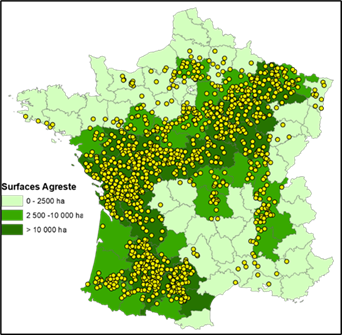Sunflower: basins and cultivation practices in full evolution
Sunflower: basins and cultivation practices in full evolution
A survey carried out by Terres Inovia in 2021 on sunflower cultivation practices shows that these practices are changing. After a multi-year statistical analysis, practices such as early sowing, as soon as the conditions of drainage and temperature are met, are favorable to higher yields.
In a multi-year trend, sunflower acreage is increasing in France. Between 2019 and 2021, it has increased from 603,616 ha to 699,000 ha (+16%). Sunflower is, for example, more present today than from 2000 to 2015 in the Centre - Val de Loire, Bourgogne-Franche Comté and Grand Est. The crop is also becoming significant in the south of Hauts-de-France (Oise in particular).
Very high average returns in 2021
The majority of production is oleic (77%), a proportion that remains stable compared to the previous survey. In addition, the 2021 sunflower season was marked by very high average yields: the national average of 31 q/ha is a historical record since at least the 1990s.
Sunflower represents, on average, 17% of the Utilized Agricultural Area (UAA) of the farms (stable rate compared to 2019). The diversification of rotations is consolidating and long and diversified successions, including sunflower, are in the majority, but short rotations such as sunflower-wheat remain present in the Southwest, after a phase of decline.

Departmental sunflower areas in 2021 (source Agreste)
More frequent plant cover before sunflower
Plant cover crops planted before sunflowers continue to increase. In 2021, they were planted on 41% of the sunflower crop, compared to 35% in 2019 and 10% in 2009.
Legume-based mixtures are in the majority (55% sunflower), followed by cruciferous crops (43%) and phacelia (30%). It should be noted that in the northern half of the country, the quality of the cover crop establishment was penalized by the very dry conditions of the summer of 2020.

Sunflower after faba bean cover on the farm of Françoise Parayre, farmer in Haute-Garonne and partner of the Syppre Lauragais network led by Terres Inovia.
Early planting leads to higher yields
The sowing of sunflower 2021 took place mainly in April (until the first dekad of May in the South-West). This is an optimal period for sowing the crop when the soil temperature and drainage conditions are met.
In fact, provided that sunflowers are sown on dry soil that is sufficiently warm at a depth of 5 cm (>8°C) to obtain regular emergence, it is in the interest of producers to sow sunflowers early, i.e. before mid-April, in order to obtain higher yields and to avoid (or limit) possible drying costs, particularly in the northern half of France.
As for the sowing density, it has changed little, the national average being 73,000 seeds/ha. The aim is to avoid high sowing densities (> 75,000 seeds per ha) with a wide row spacing (> 75 cm) which can increase the risk of lodging.
Pre-emergence weed control remains predominant
In most basins, pre-emergence weed control alone is predominant. Only the Rhône-Alpes region, with high pressure of mugwort (the leading invasive and allergenic plant in metropolitan France), uses pre-emergence and post-emergence strategies.
Note: a lower hoeing rate than the multi-year average was observed in 2021, linked in part to rainy conditions in May and June in many regions. While 73% of farmers consider their plot clean, this rate has decreased over the years (75% in 2019 and 85% in 2013), as rainy conditions have favored late grassing of plots. 11% of ha were treated with a fungicide, a stable rate compared to 2019. The main targets cited were phomopsis and phoma.
In addition, a quarter of the sunflower area does not receive any nitrogen fertilizer, either mineral or organic (organic waste products) and almost one hectare out of two (47%) has neither phosphorus nor potash. It should be noted that for any lack of these elements P & K, a preliminary soil analysis is necessary. Boron is applied on 54% of the surfaces (this rate was 29% in 2006).
Finally, in connection with the rainfall in 2021, which was much higher than average during flowering and the beginning of seed filling, irrigation was used very infrequently (2% of the sunflower areas compared to 6% in the previous survey in 2019).
Later than average harvests
En 2021, les dates de récolte se sont étalées de la deuxième décade de septembre à la première d’octobre. Ces récoltes ont été globalement plus tardives que la moyenne à cause d’un été globalement frais, et particulièrement humide en juillet, qui a ralenti le cycle de la culture mais aussi contribué à un remplissage amélioré des graines. Heureusement les conditions de maturation ont été par la suite favorables, sans pluies excessives. L'humidité moyenne des graines à la récolte dépasse les 9% en 2021 et le recours au séchage a été nécessaire dans certains bassins, en particulier dans le Grand Est. La bonne adéquation entre la date de semis et la précocité variétale, à adapter selon la zone de culture, ressort de nouveau comme un des éléments clés de réussite agronomique et économique de la culture.
In 2021, harvest dates ranged from the second dekad of September to the first of October. These harvests were later than average due to a cool summer overall, and particularly wet in July, which slowed the crop cycle but also contributed to improved seed filling. Fortunately, subsequent ripening conditions were favorable, without excessive rainfall. Average seed moisture at harvest exceeds 9% in 2021 and drying was necessary in some basins, particularly in the Grand Est. The good adequacy between the sowing date and the varietal earliness, to be adapted according to the growing area, appears again as one of the key elements of agronomic and economic success of the crop.
Method implemented
|